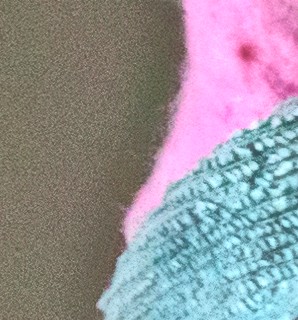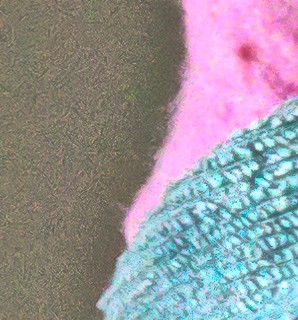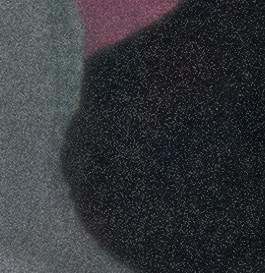Picture Postcard Workflow and raw processing: What about noise reduction?
The complexities of noise
The article about sharpening started with a comment that it is complex and subjective. Both qualifications apply to noise reduction as well, and I would say to a higher degree. Considering sharpening, one may state that practically every image requires some sort of sharpening; and that one simple sharpen action may suffice in many cases. Both statements are false when it comes to noise reduction.
So, what makes noise reduction so complex? First, a well-exposed image taken in good light may not show any noise at all, or contain so little that no correction is required. Trying to reduce it involves a risk of losing fine image detail, while giving no benefit. Next, noise comes in various manifestations. There is color noise and luminance noise. There is fine, pixel-level noise, and coarse, low frequency noise. Noise is dependent on sensor characteristics, so what applies to images taken with my camera may not apply to those coming from yours. And last but not least, noise patterns and intensities may vary between different parts of an individual image.
Given all these complexities, it is with great reserve that I provide my view on noise reduction during the raw processor phase - within the context of the PPW. I will process one example image that I believe shows various aspects of the subject. For me, the general recommendation appears to work in most cases. Keep in mind though that your mileage may vary.
Ceiling
The test
We start with the photograph of figure 1 below. Please don’t judge it on artistic merits. Instead, let's utilize these three rags to examine how to wipe out the noise as effectively as possible.
Figure 1. Original test image
I chose this image because:
- it was taken with a reasonably high ISO (800)
- it is rather underexposed, about 1.5 stops
- it contains both smooth areas and areas with fine texture
The expectation is that a PPW treatment will bring out considerable noise, both luminance and chroma. The experiment that I want to carry out is as follows, each time starting with the raw original:
- Apply appropriate noise reduction in the raw processor, execute a moderate PPW and sharpen. The result will be called version 1.
- Apply no noise reduction at all in the raw processor, go through the same PPW steps as for version 1, then apply appropriate noise reduction and sharpen: version 2.
- The same as version 2, but sharpen first and reduce noise as final step, yielding version 3.
To make the results as much comparable as possible, use the Camera Raw filter for the noise reduction of runs 2 and 3. The question of course is, what is “appropriate noise reduction”. For version 1, I will follow my own taste and experience. For versions 2 and 3, I will try to match the noise levels of version 1 before sharpening. Hence, “appropriate” noise reduction in versions 2 and 3 will be stronger than what I did in version 1, but that’s only reasonable.
As for the PPW run, I chose the following steps:
- A curves adjustment layer to correct the bad exposure, set to Luminosity mode
- A default application of the Bigger Hammer action, using the “desaturated RGB” as basis for the Overlay layer, and including Retain Original Color at the default 50%
- An application of MMM + CB, based on a selection of the full image, and toned down to 75%
- Sharpen 2015, with Soften Shadows but without Exclude Blues
The final results will be compared for noise and detail.
The three versions
So, here goes the story for version 1.
- In Camera Raw, I used all defaults except on the Details tab, where I set the values for Noise Reduction Luminance to 40, 40, 0 and for Color to 40, 50, 50. Sharpening amount 0. See figure 2.
- I hit Open Image to continue processing in Photoshop.
- In Photoshop, I started with a Curves adjustment layer to give the image proper range, see figure 3.
- Next, I applied Bigger Hammer, MMM+CB and Sharpen 2015 as outlined above. See figure 4 for what the final layer stack looks like.
The results will be shown later when all three versions are available for comparison.
Figure 2. ACR Detail panel for version 1
Figure 3. Curve as used for all versions
Figure 4. Final layer stack for version 1
Version 2 then.
- In Camera Raw, all defaults, no noise reduction and no sharpening at all. Open the image.
- In Photoshop, I applied the exact same PPW steps as for version 1, except the Sharpen.
- Next, I applied noise reduction in the Camera Raw filter, trying to match the look of version 1 before the sharpen. Used values were for Luminance 50, 40, 0 and for Color 40, 50, 50.
- The run was finished with Sharpen 2015, using the exact same options as in version 1.
And version 3 is the same as version 2, except that the noise reduction and sharpen steps have been reversed. To match the looks, the following values were used in the Noise Reduction section of ACR: Luminance 60, 30, 0 and Color 50, 50 , 50.
Time for a comparison
See figure 5 for the results. All shown at 100%, for two image areas, one light and one dark.
Figure 5. Fragments of the results. Left: version 1. Middle: version 2. Right: version 3.
First, let’s compare the luminance noise. In the light area (top row), version 1 (left) seems to have the quietest, most regular luminance noise. This is best notable on the uniform beige area. Version 3 (right) is worst in this respect. An advantage of what I call "regular" noise is that it’s most likely to fade in print, but this is just an assumption. In the dark area (bottom row), version 2 is clearly the cleanest. Version 1 is second, version 3 worst.
Next, the color noise. In the light and uniform area, I see no clear winner. In the colored and in the dark areas though, version 1 is definitely the best. Note the pinkish spots in the blue cloth in versions 2 and 3, which version 1 doesn't have at all. Version 2 and 3 are about equally bad.
And what about the detail? Here, version 1 is absolutely worst. Too much detail has vanished with the noise reduction step during the raw processing. See the pink cloth in the top images in particular. Version 2 and 3 are about equally good in this respect.
If all this leaves you confused as to what the best practice should be, no worries: a workable guidance can be drawn from the above observations. I believe it is essential to distinguish color noise from luminance noise. To me, the image shows that color noise can well be reduced during the raw processing phase. I don’t see drawbacks, and it’s beneficial for the final result.
For luminance noise though, we have to be very careful. Reduce too much in the raw processor, and small detail gets lost forever. Reduce too little and the remaining noise may become troublesome after a full PPW run. The retoucher should make an assessment whether retaining fine detail outweighs striving for a low-noise image.
Some recommendations and a list of disclaimers
In line with the above discussion, I will give you my recommendations. They are not straightforward, as multiple parameters impact the choice. Like I indicated, it's necessary to handle color and luminance separately.
- Don’t be afraid to apply a reasonable amount of color noise reduction during raw processing. In fact, it’s advisable in cases where noise can be expected: when a high ISO value was used, or when shadow areas will be significantly lightened.
- For luminance noise, the recommendation is much more conservative. Set amount to 0 when no significant noise can be expected. It’s okay to enter a positive amount in other cases, but keep it lower than say 25. The more important you consider fine image detail, the less luminance noise reduction you should apply.
- Any remaining noise (color or luminance) that is brought out by the PPW steps, can – if needed – be reduced afterwards, but preferably before sharpening.
After such carefully formulated guidelines, it’s good to give you a whole lot of relativizing remarks as well:
- I don’t have the time to do extensive experimentation. Different images may give different results.
- Images taken with different cameras may show different noise profiles, and thus lead to different conclusions.
- The original example image counts 24MP. For most prints, that is way too much, so some downsizing is appropriate. This will diminish the noise and thus the differences between the three versions.
- On screen, noise looks always worse than in print. So, if a print is the final goal, noise is never as bad as one might expect.
- The assumption that the exact same PPW steps are executed in the three versions, may be not realistic. Versions 2 and 3 came in Photoshop with more noise, so different choices may be made along the way.
- A different PPW path may lead to different results.
- If the Sharpen action causes an unacceptable noise level, then a different approach may work. Instead of following the sharpen action with a noise reduction step, some of the layers in the Sharpen 2015 group can be turned off or otherwise reduced.
- Better results can certainly be obtained if a reduce noise layer is accompanied by a mask that blocks the NR where it is not needed. For version 1, this is only possible by using the adjustment brush of the raw processor, which as far as I know cannot distinguish color from luminance noise.
And so on, and so on. See figure 6 for a final version that was obtained using my own recommendations: a bit of luminance noise reduction during the raw processing phase, and some right before sharpening. At this size though, it doesn't really matter.
Figure 6. A final version, downsized for the web
When I started writing this article, my expectation was that version 1 would give the best result, at least concerning the noise levels. By now I think differently. Noise reduction in the raw processor must be applied with reserve. A low amount can be beneficial, but more is certainly not better.
Gerald Bakker, 14 Jan. 2017
Related articles
Picture Postcard Workflow


















